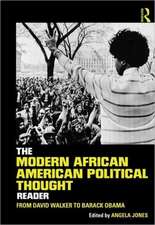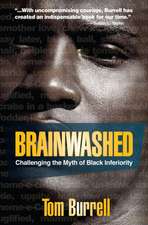African American Pioneers of Baseball: A Biographical Encyclopedia
Autor Lew Freedmanen Limba Engleză Hardback – 29 apr 2007 – vârsta până la 17 ani
Preț: 328.09 lei
Preț vechi: 564.90 lei
-42% Nou
Puncte Express: 492
Preț estimativ în valută:
62.78€ • 65.71$ • 52.25£
62.78€ • 65.71$ • 52.25£
Carte tipărită la comandă
Livrare economică 31 martie-14 aprilie
Preluare comenzi: 021 569.72.76
Specificații
ISBN-13: 9780313338519
ISBN-10: 0313338515
Pagini: 320
Ilustrații: Illustrations
Dimensiuni: 178 x 254 x 25 mm
Greutate: 0.81 kg
Editura: Bloomsbury Publishing
Colecția Greenwood
Locul publicării:New York, United States
ISBN-10: 0313338515
Pagini: 320
Ilustrații: Illustrations
Dimensiuni: 178 x 254 x 25 mm
Greutate: 0.81 kg
Editura: Bloomsbury Publishing
Colecția Greenwood
Locul publicării:New York, United States
Notă biografică
Lew Freedman is a sportswriter with the Chicago Tribune. He has worked as an award-winning journalist with the Anchorage Daily News and is the author of over 21 books.
Cuprins
Preface viiIntroduction xiTimeline xviiBuck O'Neil (November 13, 1911-October 6, 2006) 1Judy Johnson (October 26, 1899-June 15, 1989) 17Buck Leonard (September 8, 1907-November 27, 1997) 27Cool Papa Bell (May 17, 1903-March 7, 1991) 41Josh Gibson (December 21, 1911-January 20, 1947) 53Jackie Robinson (January 31, 1919-October 24, 1972) 67Roy Campanella (November 19, 1921-June 26, 1993) 83Don Newcombe (June 14, 1926- ) 99Larry Doby (December 13, 1923-June 18, 2003) 109Satchel Paige (July 7, 1906-June 8, 1982) 119Monte Irvin (February 25, 1919- ) 135Willie Mays (May 6, 1931- ) 151Willie McCovey (January 10, 1938- ) 169Ernie Banks (January 31, 1931- ) 183Elston Howard (February 23, 1929-December 14, 1980) 195Minnie Minoso (November 29, 1922- ) 209Frank Robinson (August 31, 1935- ) 223Bob Gibson (November 9, 1935- ) 237Curt Flood (January 18, 1938-January 20, 1997) 249Hank Aaron (February 5, 1934- ) 263Bibliography 281Index 289
Recenzii
The careers of 20 athletes, inlcuding Ray Campanella, Willie Mays, and Hank Aaron, are highlighted with reference to their contributions to the Negro Leagues and/or major league baseball mid-century, when their impact on the sport was most dramatic. The author's anecdotal style is especially affecting in describing his subjects, their struggles with racism, and their travails.
Freedman's approach, which includes plenty of quotations and fascinating anecdotes, such as Don Newcombe's daring to get into a public argument with a white man during spring training in Florida, makes the book both an excellent source and a compelling sports history.
This excellent and readable book tells the stories of 20 African-American baseball players, both old-timers excluded from the major leagues by segregation..and relatively newer players such as Ernie Banks, Bob, Gibson, and Hank Aaron. The book works at two levels--first, as an account of what it meant to be an African-American baseball player in the United States, and second, as a great read about very good players..There are pictures throughout, and an index, both of which add to the book's quality..This book is both educational and enjoyable, and is highly recommended.
Together, these players reflect nearly ninety years of baseball history. Freedman uses their careers to illuminate changes in both baseball and American society. His detailed accounts describe the early life, professional career and later efforts of each player. The author uses interviews, biographies, and game reports to demonstrate the character and achievements of each man. The narratives are heavily sprinkled with contemporary accounts and anecdotes, but are fully documented. As stories of success, tragedy, pain, perserverance, sports and history, this collection of biographies will prove entertaining and informative reading in both public and academic libraries.
Crafting a readable and informative history, Freedman reminds readers of the struggles of Hank Aaron and his brethren. The articles are arranged neither alpahbetically nor strictly chronologically. Instead, the order of subject coverage is chosen to best weave individual stories into a cohesive account of African Americans in baseball in the 20th century. Each lengthy selection provides details of the players' personal and professional lives as well as the abuses they suffered. Since Freedman was able to interview a few of the players, such as Buck O'Neil and Minnie Minoso, the anecdotes and reminiscences make these men seem real, and the racism they encountered that much more painful.
Chicago Tribune sportswriter Freedman explains his arrangement of the 20 biographies found here as neither chronological nor alphabetical, but laid out in a manner that best illustrates the African American baseball experience through the Negro Leagues and the barrier-breaking period in the major leagues. The lives and careers of players including Buck O'Neil, Cool Papa Bell, Jackie Robinson, Roy Campanella, Willie Mays and Hank Aaron are offered in entries averaging eight pages each, and accompanied by a few B&W photographs. A timeline of births, deaths, and major events is provided, along with suggestions for further reading.
Freedman's approach, which includes plenty of quotations and fascinating anecdotes, such as Don Newcombe's daring to get into a public argument with a white man during spring training in Florida, makes the book both an excellent source and a compelling sports history.
This excellent and readable book tells the stories of 20 African-American baseball players, both old-timers excluded from the major leagues by segregation..and relatively newer players such as Ernie Banks, Bob, Gibson, and Hank Aaron. The book works at two levels--first, as an account of what it meant to be an African-American baseball player in the United States, and second, as a great read about very good players..There are pictures throughout, and an index, both of which add to the book's quality..This book is both educational and enjoyable, and is highly recommended.
Together, these players reflect nearly ninety years of baseball history. Freedman uses their careers to illuminate changes in both baseball and American society. His detailed accounts describe the early life, professional career and later efforts of each player. The author uses interviews, biographies, and game reports to demonstrate the character and achievements of each man. The narratives are heavily sprinkled with contemporary accounts and anecdotes, but are fully documented. As stories of success, tragedy, pain, perserverance, sports and history, this collection of biographies will prove entertaining and informative reading in both public and academic libraries.
Crafting a readable and informative history, Freedman reminds readers of the struggles of Hank Aaron and his brethren. The articles are arranged neither alpahbetically nor strictly chronologically. Instead, the order of subject coverage is chosen to best weave individual stories into a cohesive account of African Americans in baseball in the 20th century. Each lengthy selection provides details of the players' personal and professional lives as well as the abuses they suffered. Since Freedman was able to interview a few of the players, such as Buck O'Neil and Minnie Minoso, the anecdotes and reminiscences make these men seem real, and the racism they encountered that much more painful.
Chicago Tribune sportswriter Freedman explains his arrangement of the 20 biographies found here as neither chronological nor alphabetical, but laid out in a manner that best illustrates the African American baseball experience through the Negro Leagues and the barrier-breaking period in the major leagues. The lives and careers of players including Buck O'Neil, Cool Papa Bell, Jackie Robinson, Roy Campanella, Willie Mays and Hank Aaron are offered in entries averaging eight pages each, and accompanied by a few B&W photographs. A timeline of births, deaths, and major events is provided, along with suggestions for further reading.










